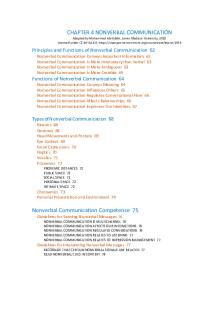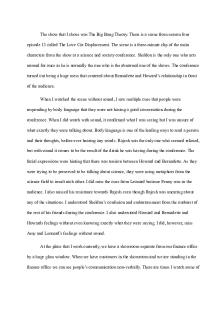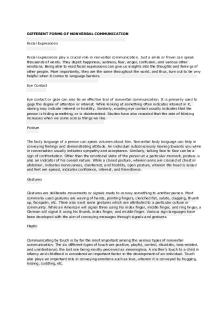Nonverbal Communication Notes for Test 4 PDF

| Title | Nonverbal Communication Notes for Test 4 |
|---|---|
| Course | Non-Verbal Communication |
| Institution | Eastern Michigan University |
| Pages | 4 |
| File Size | 52 KB |
| File Type | |
| Total Downloads | 55 |
| Total Views | 160 |
Summary
test notes ...
Description
Test 4 ------Nonverbal Communication Notes
Emblems
Direct Verbal Translation o Middle Finger Generally known within the group Largely Intentional o Usually we are very aware of what we are doing, it is on purpose o Used so constantly almost not consciously Culturally-specific Context-Specific o In one setting it can mean something completely different than a different setting.
Illustrators-Tend to be movements with our arms, but they come with language
Verbal message and illustrators must be paired o Referent- Related illustrators Referencing something o Attitude-related illustrators Thumbs up, thumbs down o Punctuation illustrators Using exclamation points to emphasize importance Using commas, bullet points, or list forms to demonstrate lists o Interaction Illustrators Meloche waving his hand a few times after asking a question, he is waving to try to control the flow of the interaction. Meloche putting his hand up to make us stop talking
Regulators- Movements we make to try to control our interactions, but subconsciously. -We do these things without being away
They are also called turn taking behaviors Turn-yielding behaviors o Looking more directly at the person we want to talk when we are finished talking. o Usually lean closer to person we want to start talking. o But we are unaware it Turn-maintaining behavior o We want to maintain the “floor” o We talk louder and faster so that there is no break in it for other people to start talking. o We don’t do this on purpose
Turn-requesting behavior- Someone has been talking for a long time o Audibly inhale (Breathing loud enough for someone to hear) o Nodding head quickly Turn-Denying behaviors o Nodding head very slowly
Illustrators and regulators are the same thing, but illustrators are consciously, and regulators are subconsciously. They are different in other cultures and different parts of the world.
Interaction Synchronicity
Being in step/sync with somebody else Unspoken rhythm that we establish with other people through conversations. It is easy if we come from the same culture
Intercultural Ramifications- It is hard for us and makes us uncomfortable interacting with someone who is/was clearly raised in a different culture. It usually raises flags for us and it gives that “bad vibe” because we have an uncomfortable interaction. Matching
Mirroring- if we want to change other people’s attitudes or behaviors we mirror the behavior we want them to present. Motor mimicry- when someone shows strong emotion about something such as getting hurt or being very excited about something. o EX-One of your friends is hanging something up and they suck at being coordinated, they go to hammer something in the wall and end up hitting themselves. They get hurt and scream “ahh”, and you end up saying “ahh” too because it sort of affects you. Emotional contagion- We usually rub off our emotions onto people and people usually rub off on us as well Meshing- two people when they have a very strong connection between them, it typically occurs when they are engaged in a conversation involving something serious. Their nonverbal behaviors synchronized together and completely happen at the same moment. o Crossing legs at the same time, their hand on their chin, eyebrows raising, etc.
Affect Displays
Emblems- gestures that we use when were positive like blowing a kiss or negative when we give someone the finger. Posture- we can tell a lot about a person’s mood or how their feeling by how they are carrying their body. o Depressing, negative, sad- we usually slouch, almost pretend were not there. We usually want more space or distance between ourselves and people.
o Happy, good mood, positive- upright Proxemics- the personal bubble for ourselves, our personal bubble expands and contracts based on personal relationship with person, how we are feeling about something. o Sometimes if we are sad or fearful we might want to be closer to someone and “be held”.
Deception/leakage cues
Too much eye contact Over playing their hand Too little eye contact Extraneous movements of hands and feet Stumbling over their words Flip flopping
If the person is acting different than they usually behave, their pitches are different, their voice, etc. Can they be trusted? --- you can’t put too much in this, you need to put two and two together. You can’t treat it as absolute.
Control/belief continuum o (words- tonality- facial expressions- body language) o We have the most control over the words we say. Sometimes we cant figure out the words we want to say, or sometimes we blurt out words on accident. o Our tone of voice is slightly less controllable We don’t have as much control over it o Facial expressions we have a little bit less control o Body language is the least controllable So much of our body language is unconsciousness Control is forward in that order People believe our body language the most and our words the least. Because of the control factor.
Adaptors-appear to serve a practical purpose
People engage in adaptors when we are born
When do we use them? “self-adaptors”- nail biting, skin pulling, hair twirling, etc. Object focused adaptors- clothing, cellphone, vape, necklace, bracelet, ring Alter directed adaptors- someone makes you nervous or something, so in the presence of another person, you cross your arms or bite your nails or something.
Posture and Body orientation
Different cultures have different assumptions they have different believes on what posture people should have and the body orientation. In the United States we prefer a direct orientation-standing in front of the other person, broadening shoulders. Parallel orientation- side by side, more casual sitting side by side, o EX- romantic couple comes into a restaurant and sits in a booth next to each other. In other parts of the world it is not expected to have a direct body orientation. Expansion and shrinkageo Typically, it is the males that usually are in expansion. They tend to try to take up more space, broadening shoulders, how men walk and carry things, they take larger steps, if they cross their legs they cross it at the ankle to take up more space. o Typically, women engage in shrinkage. If they carry books its close to themselves, take smaller steps, they try to take up less space. Inclusion and exclusionInfluence of statuso If the other person in the conversation is of similar status, we tend to engage in the matching behavior, and we tend to engage in the same body language. o If there is someone of different status, our expectation is the person with the least amount of status will stand up and use a direct orientation. The person with the most status doesn’t have to do that at all. This is a United States thing....
Similar Free PDFs

Chapter 4 Nonverbal Communication
- 19 Pages

6 - Nonverbal Communication
- 1 Pages

CH 5 HW: Nonverbal Communication
- 2 Pages

Test 4 - Notes
- 19 Pages
Popular Institutions
- Tinajero National High School - Annex
- Politeknik Caltex Riau
- Yokohama City University
- SGT University
- University of Al-Qadisiyah
- Divine Word College of Vigan
- Techniek College Rotterdam
- Universidade de Santiago
- Universiti Teknologi MARA Cawangan Johor Kampus Pasir Gudang
- Poltekkes Kemenkes Yogyakarta
- Baguio City National High School
- Colegio san marcos
- preparatoria uno
- Centro de Bachillerato Tecnológico Industrial y de Servicios No. 107
- Dalian Maritime University
- Quang Trung Secondary School
- Colegio Tecnológico en Informática
- Corporación Regional de Educación Superior
- Grupo CEDVA
- Dar Al Uloom University
- Centro de Estudios Preuniversitarios de la Universidad Nacional de Ingeniería
- 上智大学
- Aakash International School, Nuna Majara
- San Felipe Neri Catholic School
- Kang Chiao International School - New Taipei City
- Misamis Occidental National High School
- Institución Educativa Escuela Normal Juan Ladrilleros
- Kolehiyo ng Pantukan
- Batanes State College
- Instituto Continental
- Sekolah Menengah Kejuruan Kesehatan Kaltara (Tarakan)
- Colegio de La Inmaculada Concepcion - Cebu










![Document title] Test of Nonverbal Intelligence (TONI-4](https://pdfedu.com/img/crop/172x258/97qg3oq312v6.jpg)
